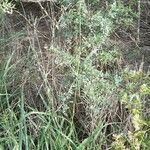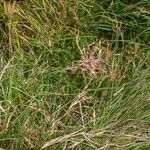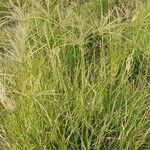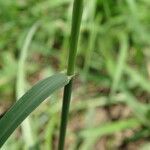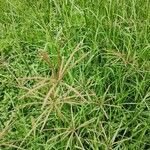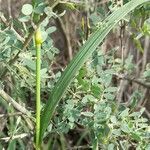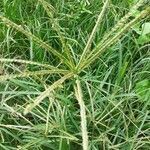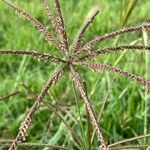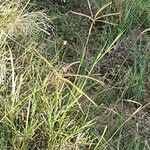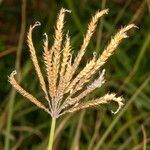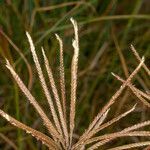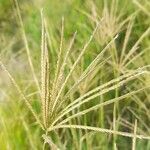Perennial, stoloniferous. Culms erect or ascending, usually rooting at lower nodes, ± flattened, hard, 1–1.5(–2) m tall. Leaf sheaths glabrous except mouth; leaf blades flat, 15–35 cm, 2–10 mm wide, scabrous, apex acuminate; ligule ca. 0.5 mm, with long hairs behind. Racemes digitate, 5–20, ascending to spreading, 4–11 cm, greenish brown; rachis scabrous. Spikelets with 3 or 4 florets, 2-awned; lower glume 1.5–2.5 mm; upper glume 2.5–4 mm including awn-point; lemma of fertile floret elliptic to oblanceolate in side view, 2.5–3.5 mm, shortly appressed-sericeous on lower margins, usually a tuft of hairs 0.5–1.5 mm on upper margins, keel glabrous or sparsely to densely sericeous; awn 2–6 mm; second floret usually male, narrowly lanceolate or cuneate, lemma ciliate on margins, body and awn a little shorter than fertile floret; third (and fourth) florets reduced to oblong or clavate awnless scales, less than 1 mm. 2n = 20, 30, 40.
Tufted perennial 500-1 200 mm high; with stolons; basal leaf sheaths strongly keeled. Leaf blade 250-500 x 3-9 mm, tapering to a fine point. Inflorescence digitate, racemes 7-20, 40-150 mm long, green, greenish-brown or light brown; spikelets overlapping for most of their length. Spikelet 3-5 mm long, 3 or 4-flowered; lower glume 1.5-2.5 mm long; upper glume 2-4 mm long; lowest lemma 2.5-3.5 mm long, lanceolate-ovate, sparsely to densely hairy on the margins and keel, with hair length increasing upwards on margins, sometimes margins hairy only near apex, apical hairs 0.5-1.0 mm long, awn 3.4-7.0 mm long, callus rounded; second lemma 1.5-3.0 mm long, lanceolate, glabrous or rarely hairy on the margins and keel, awn 1.5-5.5 mm long; third lemma reduced to an awnless, glabrous, clavate scale 0.75-2.00 mm long, occasionally similar to the second, but then with a rudimentary fourth floret; anther 1.0-1.5 mm long.
Stoloniferous, tufted perennial, 0.5-1.2 m high; basal leaf sheaths strongly keeled. Leaf blade tapering to a fine point; ligule a short, fringed membrane or fringe of hairs. Inflorescence digitate, of 7-20 racemes, 40-150 mm long, green, greenish brown or light brown. Spikelets 3-5 mm long, laterally compressed; glumes unequal, membranous, keeled, 1-nerved. Florets 3 or 4; lowest lemma lanceolate-ovate, sparsely to densely hairy on margins and keel, hair length increasing upwards on margins, sometimes margins hairy only near apex, apical hairs 0.5-1.0 mm long, awn 3.4-7.0 mm long, callus rounded; second lemma lanceolate, glabrous or rarely hairy on margins and keel, awn 1.5-5.5 mm long; third lemma reduced to an awnless, glabrous, clavate scale, occasionally similar to second, but then with a rudimentary fourth floret; anther 1.0-1.5 mm long. Flowering time Nov.-May.
Perennials, erect, with or without stolons. Flowering culms 45–120 cm high. Leaves: ligule 0.4–0.6 mm long; blade 14–28 (–60) cm long, 3–6 (–10) mm wide. Inflorescence branches 6–18, appressed to spreading, 5–10 cm long. Spikelets subsessile, 3-or 4-flowered, with 1 or rarely 2 florets bisexual. Glumes smooth or scaberulous, with midnerve scabrous; upper glume 2.2–3.5 mm long. Callus sparsely bearded. Basal lemma (2–) 3–4 (–4.2) mm long, obscurely lobed, cartilaginous, often sulcate each side of midnerve, smooth, pubescent on the lower submargins, with erect, silky, submarginal hairs 0.5–1 mm long near apex, rarely pubescent on the lower midnerve; awn 1, (1.5–) 2–3 (–6.5) mm long. Caryopsis not seen. Incomplete florets 2 or 3, appressed to or separated from the bisexual floret; lemma obtuse or truncate, notched, inflated, the first awned, the remainder awnless.
Perennial; up to 1.2 m high; stoloniferous and tufted. Leaf blades 250-500 x 3-9 mm; basal leaf sheaths strongly keeled; uppermost leaf not inflated. Flowers: inflorescence digitate; spikes 7-20; 40-150 mm long; spikelets 3-5 mm long; overlapping for most of their length; lower glume 1.5-2.5 mm long; lowest lemma 2.5-3.5 mm long; sparsely to densely hairy; apical hairs 0.5-1.0 mm long; awn 3.4-7.0 mm long.
Perennial, stoloniferous and tufted, up to 1.2 m high. Leaf blades 250-500 mm long, 3-9 mm wide, basal leaf sheaths strongly keeled. Spikelets 3-5 mm long. Spikes 7-0.40-150 mm long; spikelets overlapping for most of their length; lower glume 1.5-2.5 mm long; lowest lemma 2.5-3.5 mm long, awn 1-10 mm long, shorter than or as long as body of lemma.
Stoloniferous perennial to 1.2 m. Leaves linear. Spikelets in 1-sided, digitate spike-like racemes, 3-5 mm long, awn to as long as lemma, 1-10 mm.
